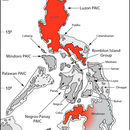en
names in breadcrumbs


For more detailed description of color (often from preserved specimens), see Brown and Alcala (1980).
The unique, type specimen is presumed missing (Brown and Alcala, 1956, 1980); a single specimen from Luzon Island has been assigned to this species (Brown and Alcala, 1956, 1980).
(Coloration in preservative; Brown and Alcala, 1980)
Dorsal Coloration: dirty tan without darker specks noted by Girard (1857) for the type
Lateral Surface Coloration: brownish band extending from eye region to base of tail
Ventral Coloration: light ivory
All species in the genus can generally be described as slender, small species of skinks (= lizards), with well-developed but slender limbs. All species possess some degree of longitudinal stripes or bands down their dorsal and dorsolateral surfaces. Previous taxonomic assessments of Philippine species in this genus recognized two distinct species groups, one group containing species with the external ear opening covered by scales, and the other group containing species with exposed tympanum (see Brown and Alcala, 1980). Several of the eight currently recognized species are likely complexes of unique, albeit morphologically similar species, and large scale taxonomic revisions are needed before an appropriate measure of species diversity can be made.
This species has traditionally been considered a member of Group 2 species in the genus Lipinia in the Philippines, with tympanum visible and not covered by scales and the position of the ear noticeable by an external ear opening.
Lipinia vulcania can be distinguished from congeners by the following combination of characters: (1) tympanum not covered by scales; (2) position of ear evidences by exteranl ear opening; (3) number of midbody scale rows 30-32; (4) vertebral scale rows between parietals and base of tail about 65; (5) 4th toe lamellae about 18; and (6) dorsum with small dark spots on lighter backgbround; dark brownish band on upper lateral surface (Brown and Alcala, 1980).
This species is currently recognized to occur on Luzon Island as well as western Mindanao Island.
Luzon and Mindanao Pleistocene Aggregate Island Complexes (PAIC; Brown and Diesmos, 2002).
SVL 26.4 mm (juvenile; Brown and Alcala, 1980)
Zamboanga Peninsula, Mindanao Island, Philippines; depository of the type unkown (Brown and Alcala, 1980). Brown and Alcala (1956, 1980) report that Girard's (1857) type specimen was not located at either the United States National Museum or the Philadelphia Academy of Sciences. As these were reported to be the most likely repositories, the holotype is presumed lost (Brown and Alcala, 1956, 1980). A single specimen deposited at the California Academy of Sciences (CAS 16472) from southern Luzon Island has been reported to match the description of L. vulcania (Brown and Alcala, 1956, 1980). This disjunct distribution should be viewed as suspicious, and the Luzon population may represent a distinct species, or have been misidentifieD. Unfortunately, without additional collections of L. vulcania from the type region in the Philippines, it will be difficult to resolve the status of this enigmatic, presumably arboreal species.
Lipinia vulcania, also known as the vulcan lipinia, is a species of skink endemic to the Philippines.[1][2] It is known from two specimens:[1] the holotype was collected at ca. 1700 m above sea level on Mindanao Island in 1857,[1][2] and another one in southern Luzon in 1956.[1]
Lipinia vulcania, also known as the vulcan lipinia, is a species of skink endemic to the Philippines. It is known from two specimens: the holotype was collected at ca. 1700 m above sea level on Mindanao Island in 1857, and another one in southern Luzon in 1956.